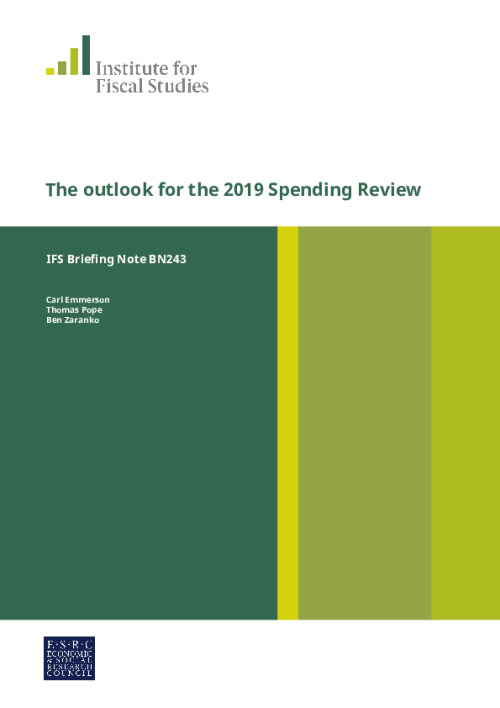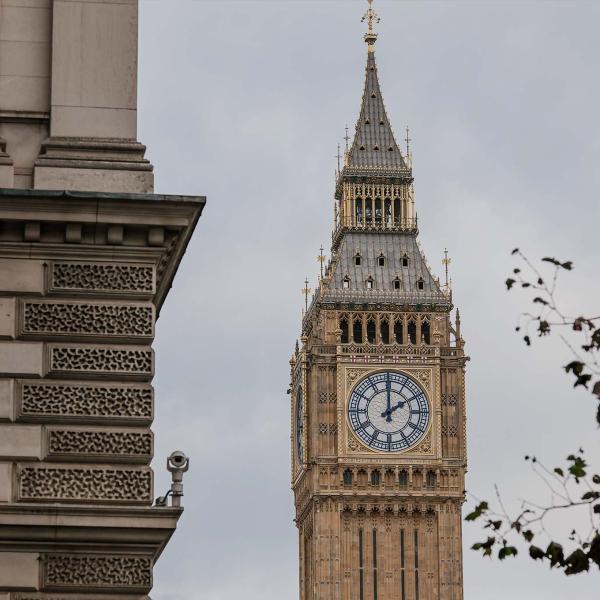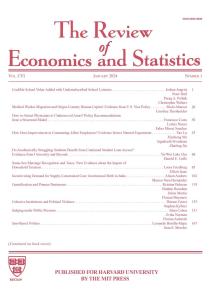At some point in 2019, the Chancellor will need to publish the outcome of HM Treasury’s forthcoming Spending Review. At a minimum, this will set detailed departmental allocations for the 2020−21 financial year, and possibly beyond. The Chancellor is yet to confirm how much he plans to spend overall (what is known as the ‘spending envelope’), but did set out some provisional spending totals in the 2018 Autumn Budget for the years up to 2023−24. These provisional totals underpin the official fiscal forecasts and therefore provide an indication of what we might expect.
Of course the economic and fiscal forecasts are always subject to change. In the October 2018 Budget the fiscal outlook improved by around £18 billion a year by 2022–23: a largesse that the Chancellor used to top up his spending plans rather than to cut taxes or reduce the outlook for the deficit. Since then the economic forecasts from the Bank of England have been revised downwards. Whereas in November the Bank of England was forecasting growth over the next current year to be slightly higher than the Office for Budget Responsibility (OBR, 1.7% compared to 1.6%) on the 7 February they revised this forecast down to growth of just 1.2%. A downgrade of GDP of 0.5% would reduce annual GDP by around £10 billion and a rule-of-thumb suggests it would add between around £5 billion and £7 billion to the deficit. Of course the OBR might not revise their forecasts down and it remains the case that the Bank of England is more optimistic than the OBR about growth in 2020 and 2021.
The Spring Statement, scheduled for 13 March, will contain the latest official economic and fiscal forecasts. It will also be an obvious moment for the Chancellor to confirm the envelope for this year’s Spending Review. On the other hand, he could wait until more is known about the Brexit deal and its effects on the economy. In any case, it is hard to see how allocations can be delayed beyond the Autumn Budget which, on the basis of past practice, suggests that the overall envelope is likely to be announced before the summer.
This briefing note provides background and context for the forthcoming Spending Review, outlining the constraints the Chancellor will be working under and the implications of his provisional plans for public service spending.
Key findings
The 2019 Spending Review will allocate funding to departments for the 2020−21 financial year, and possibly beyond. A longer, multi-year review period could aid departmental planning. But given the degree of uncertainty, the Chancellor may opt for a shorter review period to retain more flexibility.
The Chancellor’s decisions will follow almost a decade of spending cuts. On a like-for-like basis, departmental spending is more than £40 billion lower in 2018–19 than in 2009–10 and has fallen to a share of national income last seen in 2000–01. At 38.2% of national income, total government spending is roughly where it was in 2006−7
Some areas of spending have been squeezed much harder than others. For instance, while the Department for International Development enjoyed a 25% increase in its day-to-day budget between 2010−11 and 2019−20 (the final year of the last Spending Review), the Ministry of Justice and Department for Environment, Food and Rural Affairs have each seen a reduction of around 40%.
Borrowing is now back to pre-crisis levels. Debt, however, is 50% of national income higher than it was a decade ago, and is set to fall only slowly over the next few years.
The government has already committed an extra £20.5 billion to the NHS by 2023–24. Given other existing commitments on defence and aid, the path for over half of day-to-day public service spending (£156 billion in 2018–19) has already been largely decided.
Before setting individual departmental budgets, the Chancellor needs to decide how much to spend in total. Due to pre-existing commitments, the overall size of the ‘spending envelope’ will determine how tight settlements will be for ‘unprotected’ areas. The latest provisional totals imply an increase in overall day-to-day spending, but cuts to areas outside of the NHS, defence and overseas aid.
Over the four years from 2019–20 to 2023–24, the Chancellor would need to find an extra £2.2 billion to avoid real cuts to ‘unprotected’ spending overall. He would need to find an additional £5 billion to avoid this spending falling in per-capita terms and £11 billion to avoid it falling as a share of national income.
A disorderly Brexit would be likely to lead to lower economic growth in the short and long run, but may not mean less money available at this Spending Review. This would eventually require lower spending, or higher taxes, than would otherwise have been the case. But a fiscal tightening would not need to happen immediately, and there could be a case for more spending over the next few years, not least to assist with border issues and to mitigate the impacts for the worst-hit sectors or areas.











